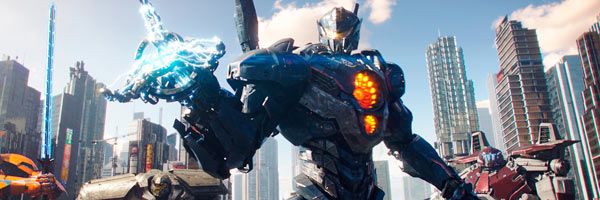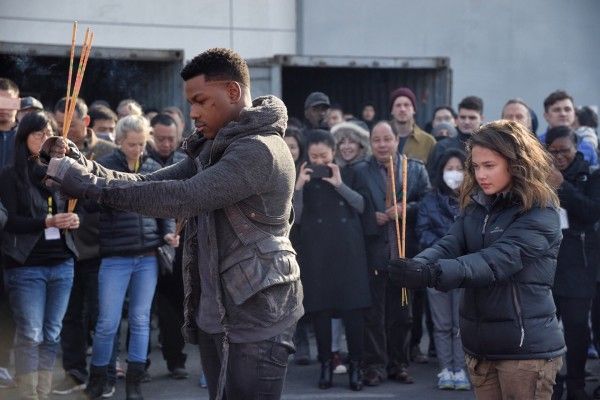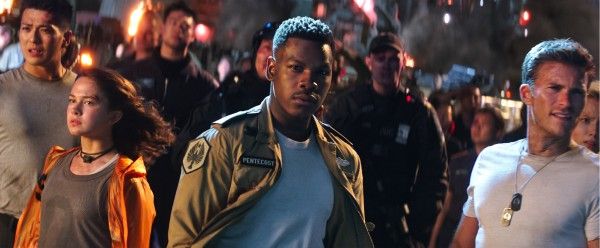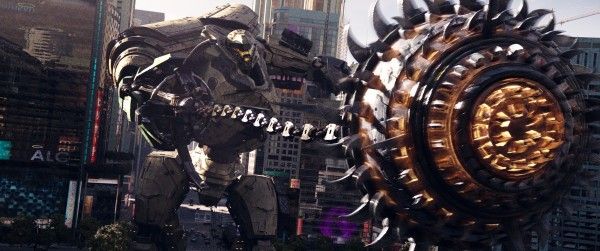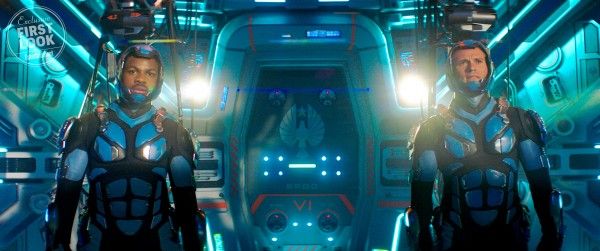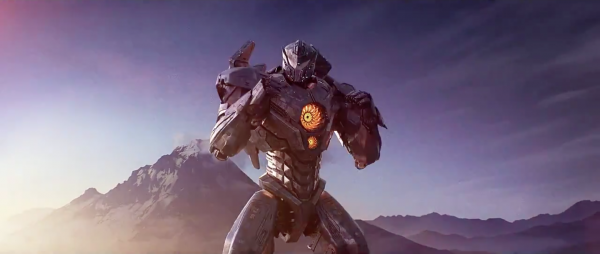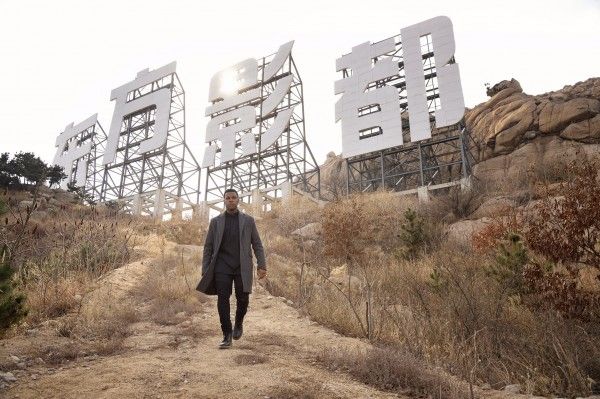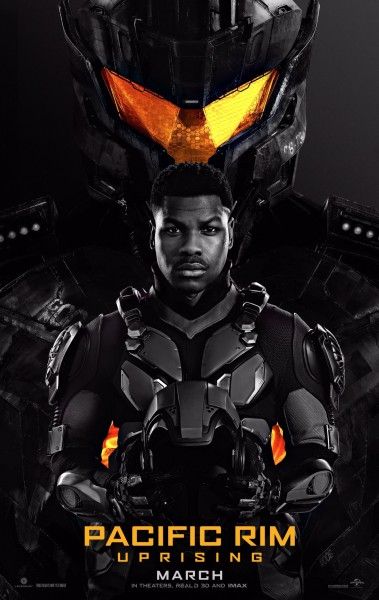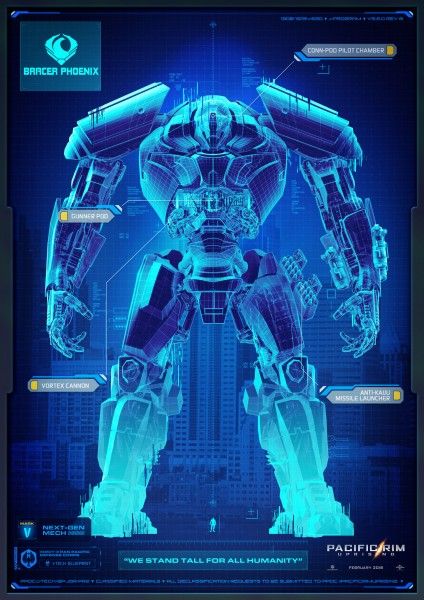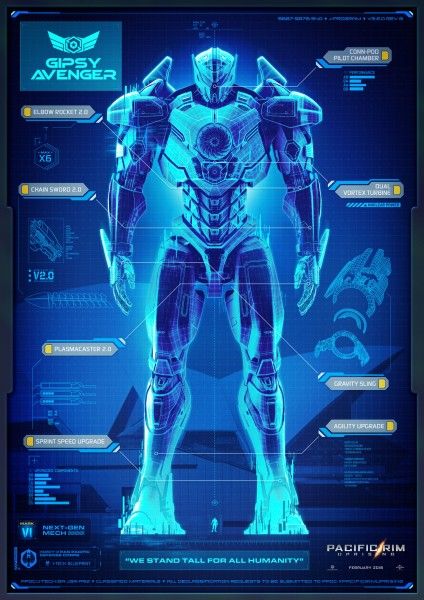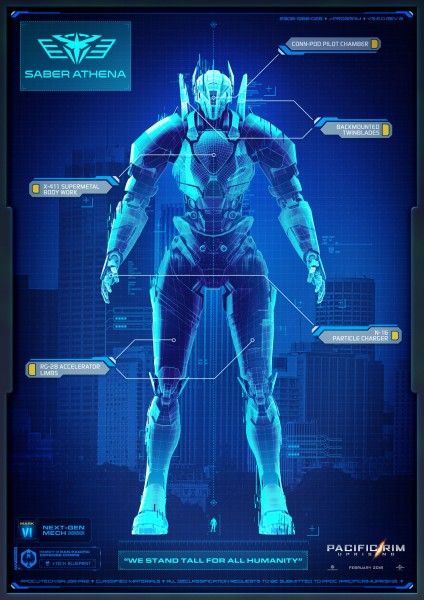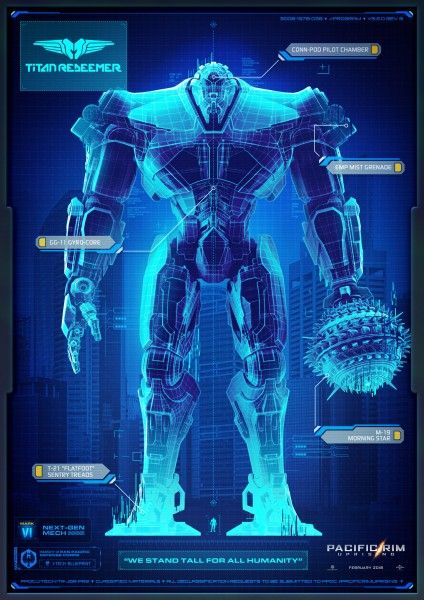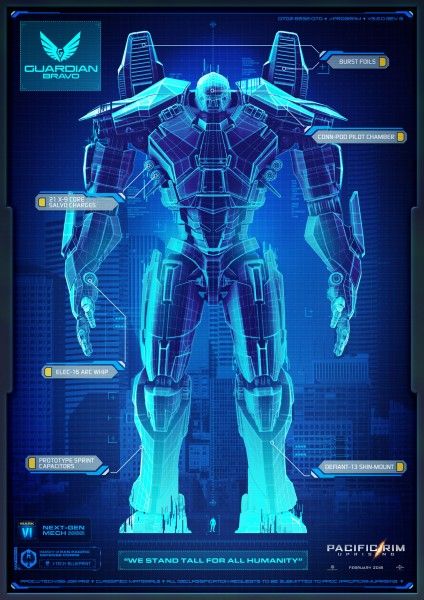It's safe to say that Steven DeKnight is having a busy day. Between coordinating action shots with John Boyega and Scott Eastwood in an intricately designed Jaeger Conn-Pod, and holding court with a group of info-hungry journalists, DeKnight's ability to multitask is being seriously put to the test. But that doesn't stop the director of Pacific Rim Uprising's enthusiasm for answering our probing questions about the upcoming follow-up to Guillermo del Toro's modern monster classic, which adds fresh faces like Boyega, Eastwood and newcomer Cailee Spaeny to the cast, and picks up ten years after the conclusion of the first film.
During the chat with DeKnight and Pacific Rim: Uprising's producer Cale Boyter, we got insight into how the sequel utilizes the world built by Guillermo del Toro, why the film's stars are significantly younger than the stars of the first film, what the tone of the sequel is, how working on Daredevil helped DeKnight handle his first feature film, and what of del Toro's original sequel script remains today.
Check out the full interview below.
Clearly there are ties to the first movie but does this function as a standalone for people?
CALE BOYTER: Yes, absolutely, that was a big part of it.
STEVEN DEKNIGHT: We built it so if you want to just watch this movie, all the information you need is in there.
I'm curious how you both utilize and build on top of the world-building that's already been established in the first Pacific Rim?
DEKNIGHT: We always wanted for the fans of the first movie, when they watch this, it will be a very rich experience. They'll catch a bunch of stuff, but you don't have to know about the first movie. Without giving anything away, the opening of this movie catches you up in a unique way.
So is it a two-hander between Jake (Boyega) and Amara (Spaeny)?
DEKNIGHT: In a way, in a way. We really wanted Jake to be our entrance back into the world and for Amara that storyline is to include a separate part of the world we haven't seen yet. So between the two we cover both bases and the story really function as how they intertwine throughout the movie.
We've seen this shift for blockbusters to consciously try and appeal to a worldwide audience, but the first Pacific Rim was very organically a world story. How are you building on this in the second film?
DEKNIGHT: It's the same thing, part of the movie being a China element but what really drew me to this was something I loved about when I did Spartacus, all these cultures that were together, and they were just together. For this movie it functions in such that organic way, the way China and Japan and Russia and Latin America and all the countries came together to fight this threat it was really baked into the story. So it never felt like “Oh we're reaching to jam in this Chinese character,” it all just made sense. It certainly helps that these countries are all on the Pacific Rim.
BOYTER: “You'll see more Chinese speaking in the movie, it's a fun dynamic between Jing Tian and Charlie Day where he's trying to learn Mandarin and he's really bad at it.”
Another neat thing from the first movie is Crimson Typhoon, the Jaeger with three pilots, are there any in this film with three or more pilots?
DEKNIGHT: I can't give you any specifics on the Jaegers but we've mixed some stuff up that we think is pretty cool. We definitely wanted to take what Guillermo did in the first movie with those Jaegers and explore different venues and different options on what they do and how they do it.
BOYTER: There's been a focused effort to make each one of these things special. They will all do things that you don't expect.
DEKNIGHT: Early on, Cale, when we had the concept art and he came in and wisely said “Okay, but what's the "Why" button on each of these?” and it was like a light bulb went off in all of us “Oh yeah! The 'Why' button.”
You mentioned earlier how, having looked at Pacific Rim, that the audience that turned out was younger and more female than expected. So how are you now speaking to those fans who turned out for the first one in a more direct way?
DEKNIGHT: I think first and foremost, I've always been of the opinion if you craft a good movie or TV show, they'll come to it. You don't have to target the female audience or the young male audience. First and foremost that is what we wanted to do, was tell an interesting story, and coming from the Joss Whedon camp I always love a strong, female central character. Where the character of Amara comes in was our gateway into a separate part of this world that we all really wanted, and really felt like it was not pandering to the female audience, she just felt like a better character if she was female. As a male character we all felt "I’ve kinda seen it before," and it just loses something. That really I think will be our good intro into it, but to me the biggest thing is just make an entertaining movie.
BOYTER: I would say just to follow through on that, we've widened the reach of what this movie is by using kids. We always talked about, thematically, the idea that anyone can matter, no matter how many skeletons you have in your closet or how old you are or where you're from. That's a pretty brazen idea that comes through and the way we use Jake and Amara, that's the thread between the two. Lambert, Eastwood's character, he's like Maverick so it's not surprising that he is going to kick ass.
To segue into the Conn-Pod stuff, not only are kids piloting this thing but with the design we pulled the action inside. They're in the fight, they're not so pent up. When they fight, it's like they're fighting and the idea is to take anything you see outside the robot is then reflected in a hologram situation, so when a missile comes at them you see it coming in. We wanted to create something a little bit more visual and fun for kids to grasp onto. I think that's a slight think but I think it's going to help people go “Oh, I can't wait to do that.”
DEKNIGHT: The movie is for big kids like us. In constructing al these stuff, really we were like "What would be really cool to do?” because first and foremost we approach this as fans of movies like this who want to go in and have a great idea.
Is the tone for this is, for a lack of a better word, a little more "fun" than the first one, how does that relate to the stakes that we're dealing with?
DEKNIGHT: I think we hit the personal stakes and the global stakes really hard. I mean, again, coming from the Joss Whedon camp, I love a little tragedy with my fun, so the stakes are definitely there. We never want this to feel like it's so light and fluffy that nothing matters, it very much matters to everyone and there are real world consequences to what happens and the decisions that people make in the movie. Without ever losing sight of the fact that we want it to be a fun ride, we still want it to be very grounded and real.
You talked a little about the advantages of Amara being a female character as opposed to a male character, does that have something to do with the idea of a “male mechanic” character is more of an established stereotype?
DEKNIGHT: It does, and it's also just, we went back and forth for a while considering possibly male or female and just looking at the script it felt like it lost something if this was a young guy saying the things that she says, and it's that almost indefinable quality that was really hard to peg down but we just all agreed when we started talking about it that it lost a bit of its magic.
BOYTER: I think it's more fun to underestimate your heroes and it's easier to do that with a young girl who wants to project a certain toughness, but you know she's really fragile and scared shitless inside. The sequence where that comes through, in terms of the stuff that we've shot and you can sense it. She's developed a little bit of a muscle, a bit of a toughness, but it's not realistic to assume "Oh, she can handle anything." She's 15. So it just helps with the idea of an underdog.
With the first film a lot of the monsters it was clear “Oh this is your King Kong monster, this is your Rodan,” when we see this will we look at the Kaiju and say “Oh that's ___!”
DEKNIGHT: I don't think you will. We were very cognizant of trying to create some truly unique creatures and I can't say a lot about it, but there's some very cool variations to what these creatures are and what they do.
Is there a sense of escalation still? Obviously that was
DEKNIGHT: ALWAYS a sense of escalation.
Guillermo's style was symmetry in monsters, is that something when you're designing a monster are you thinking of symmetry or are they asymmetrical monsters?
DEKNIGHT: We went down so many paths with these. It's honestly a little bit of both, it depends what stage you are in the movie.
One thing about the end of the first one is they close the breach, there are no more Kaiju, and that is a very natural conclusion. Is that something you've have to completely wipe off the table?
DEKNIGHT: I actually always approached it that they didn't blow up the entire alien world, it was just the opening of what looked like their monster warehouse. So you also have to assume that creatures who have mastered inter-dimensional travel have many worlds and have conquered many worlds, and I think that's referenced in the first one. My thing was, they plugged up one hole, of course they're still out there and probably pissed off. So that was a very easy natural thing, but we did want the time period to go by a lot longer where it's the question of “Are they ever coming back?”
So in the ten years since the two films, have there been any more Kaiju attack?
DEKNIGHT: I say nothing. My lawyer says I do not have to answer that.
This has been such a lengthy pre-production process with a lot of hands in the writing of this script. Can you tell me, at the end of the day, who's really got the hefty writing credits on this thing?
DEKNIGHT: I will take you quickly through the process. When I came on there were three other drafts of the script that were developed through the years, I read them and there were great elements of each one, so I cherry picked the best parts of three scripts, which was fantastic to have that opportunity. Then I put together a story, a structure, and we had a writer's room for two weeks and Emily Carmichael and Kira Snyder were part of that writer's room. Then at the end of those two weeks we spent a couple of weeks, me, Emily, and Kira, doing an outline. Then I sent Kira and Emily off to write the script because we only had like three weeks to write it at that point, and as they were writing, I was rewriting, and then we had a draft of the script at that point.
Then, if I remember the story correctly, I turned it in, Legendary loves it, and literally 24 hours later, Charlie Hunnam announces he was doing the Papillon remake and wasn't available so we had a bit of a scramble to re-conceive the idea and we brought in the amazing T.S. Nowlin, who did the Maze Runner movies, to come in and help with some of the heavy lifting. We wanted to keep the story we had, just take Hunnam out of it and re-allign it. So we did some amazing work and I started polishing it up and here we are. So it was a fantastic experience working with some amazing writers, some of them I never met because they had done the previous scripts.
With your experience in television, does that help you coming into that?
DEKIGHT: Oh hell yeah.
BOYTER: We would never be able to do with what we were able to accomplish without that.
DEKNIGHT: On all sides, the TV side helped so much because you're so used to TV as just all dog piling on a script and getting it done.
How different is this from your TV work? What are the things that were similar to that?
DEKNIGHT: It is, and thankfully the shows that I've directed on from Angel, Smallville, Dollhouse, Daredevil, it's kind of been the same genre world. I'm used to dealing with action and visual effects, it's just on a much bigger scale. Part of that much bigger scale is that it's a much longer shoot. So I always say that I feel like I'm doing what I've been doing before, it's just been expanded and I have a lot more toys. Literally. The support on a big movie is just incredible, you get so much support. It's a long grueling shoot but the crew is fantastic, everybody working on it is great, and the actors have been wonderful. I feel I really lucked out for my first tiny, little movie.
We're coming into a time where the diversity casting is an issue everyone is talking about, and it was part of the original film with Mako and the story being worldwide, so in approaching a film like this are you addressing that and how do you deal with the inherent politics of making a movie like this?
DEKNIGHT: Again, it was baked in from the first movie and was one of the things that drew me to it. It was the international civilization coming together to fight a common threat in that grand sci-fi theme. So it was all easily baked in. Really the toughest part about it was deciding where each character came from and then Casting trying to find someone that fit that region. There was some sliding around “Okay we can't someone from here, let's find someone from here.” We didn't want to be bound by exactly what it said in the script, we just wanted to find the best people and then adjust the script.
I don't know how much you guys can speak to it, but just talking about the Kaiju, in the first movie we learned about their biology. Is that something that you're still continuing to build on, the idea of what Kaiju are?
DEKNIGHT: Yup, you will learn more.
BOYTER: I like to look at it as there are a lot of things when you watch the first movie that leave questions and we looked at what all those are, and we take ideas from them.
Do you address the line “It was the dinosaurs!”?
DEKNIGHT: Without giving something away, dinosaurs are mentioned.
Pacific Rim Uprising hits theaters March 23, 2018. For more from our set visit, click on the links below.

